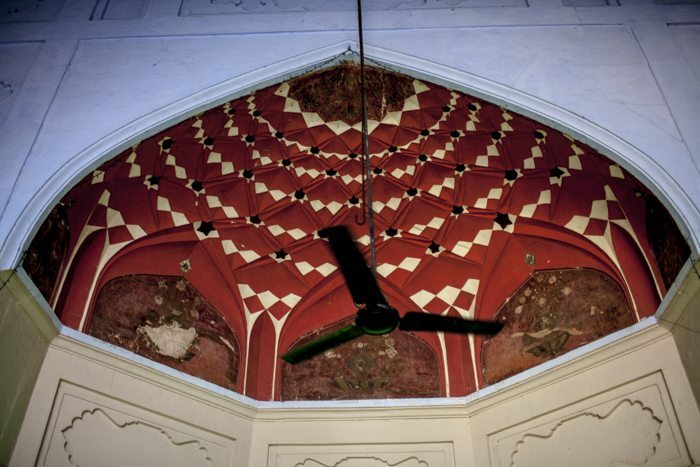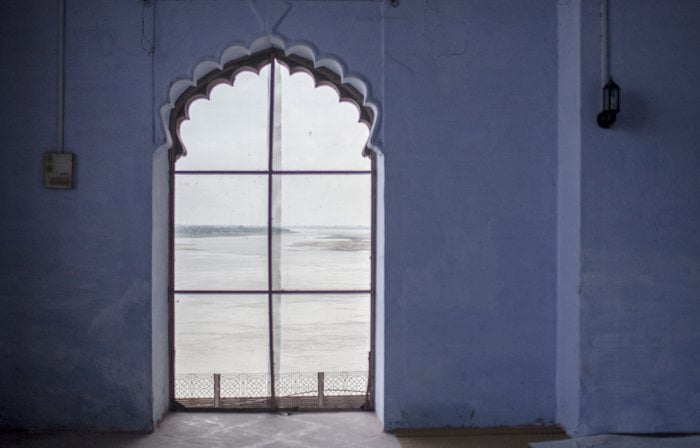“Two groups amongst My Ummah would be such, to whom Allah has freed from fire; One group would attack India & the Second would be that who would accompany Isa Ibn-e-Maryam (A.S.)”
quote taken from a translation of the Hadith
India is widely considered to be a country of immense spirituality. Its religions are diverse and diffused across its cultures and ethnic backgrounds, with Hinduism assuming the major share of its population with almost 80% being adherents. This is followed by Islam with some 15% and the remainder follow Christianity, Sikhism, Buddhism, Jainism and indigenous ethnic faiths. Religious diversity and religious tolerance are both established in the country by the law and custom; indeed the Constitution of India has declared the right to freedom of religion to be a fundamental right.
The Alamgir Masjid, standing high on the river banks of Varanasi, was converted from an 11th century Vishnu temple. After its first destruction in the 15th century it was rebuilt in 1585 by the king of Amber, Raja Man Singh, but finally demolished and transformed into its current form in 1673 by the Mughal emperor Aurangzeb. It continues to have the distinction of being Varanasi’s largest river side structure.
Islam came to India in the early 7th century with Arab traders landing at the Malabar coast, Kerala. It became a major religion during the Muslim rule in the Indian subcontinent. Islam’s spread in India mostly took place under the Delhi Sultanate (1206–1526) and the Mughal Empire (1526–1858), greatly assisted by the mystic Sufi tradition. As of 2011, there were about 177 Million Muslims in India, comprising 14.2% of the total population.
The relationship between Muslims and followers of other religions of India has often been turbulent, culminating most violently in the Partition of India in 1947, when massive population exchanges between Muslims and Sikhs and massive violence and slaughter occurred on both sides of the borders. Varying claims state that between 200,000 and 1,000,000 people into total were estimated to have been killed.
Since the Partition, fuelled in part by tensions between the ideologies of Hindu Nationalism and Islamic extremism, India has witnessed sporadic large-scale violence between sections of the Hindu and Muslim communities. These include the 1966 Gujarat riots, 1970 Bhiwandi Riots, 1983 Nellie massacre and the 1989 Bhagalpur violence. These were followed by the Bombay Riots and 1993 Bombay Bombings, and tensions through the 1990 in Kashmir and more recently in West Bengal and Assam.
These events have also led to an increase in the ghettoisation of Muslim communities, and subsequent stereotyping and reduction of economic and educational opportunities within them.
It is difficult perhaps to consider Islamist issues without considering the wider fundamentalist movements in the middle east, south Asia and parts of Africa. Some radical Islamists invoke the Hadith ( oral traditions associated to the Prophet Mohammad ) to prophesise a great forthcoming battle in India which has been called the Ghazwa-e-Hind. Victory in that ‘final’ battle, essentially that of ‘believers’ over ‘non-believers’, would mean India returning to an Islamic caliphate under Sharia law.
The Hadith generates considerable debate regarding its authenticity as well as to the true meaning of the sayings attributed to Mohammad himself and collated 100 years after his death. Some Muslim scholars proclaim the book to be fake and written entirely for political gain, some that the proclamations have in fact occured and refer to the periods of historical Moghul domination in India, whereas some suggest the statements are metaphorical and should be taken as such. Others suggest that these ancient words must be taken literally, that the battle will occur and global recruitment is necessary. It is these latter scholars who inform the current views and aspirations of al Q’aeda and ISIS.
Some examples of how this latter view is currently being spread include :
The Pakistani offshoot of the Taliban, Tehrik-e-Taliban Pakistan (TTP), which has declared war on the Pakistani state, maintains that their war is the Ghazwa- e-Hind forecast by the Prophet Muhammad. In their interpretation, the reference to India is said to cover Afghanistan, Pakistan and India.
The militant Islamist group Jamaat ul Ahrar has promised that “our jihad will not stop till Pakistan is conquered but we will keep fighting until entire Hind is under the Sharia of Allah. We shall keep going and conquer every country in our path [with Allah’s will] until we reach Filisteen (Palestine) and there we shall erect the black flags in al-Quds (Jerusalem).
The Islamic Movement of Uzbekistan (IMU), an affiliate of al-Qaeda, has also adopted the broader definition of battle for the Indian subcontinent by naming its Urdu-language magazine “Ghazwa-e-Hind.”In May 2014, IMU released a video of its Mufti Abuzar Azzam discussing Ghazwa-e-Hind. He argued that “Hind” includes not just India but also Pakistan, Sri Lanka, the Maldives, Kashmir, Burma, and Bangladesh; and explained that the jihad in Pakistan—a part of Ghazwa-e-Hind—is necessary for the success of the jihad in Afghanistan—the jihad in Khurasan.
One South Asian ISIS member proclaimed, “our struggle is ongoing and Insha’Allah after defeating Pakistan Army, we won’t just stop in Pakistan rather we shall continue our advance into Kashmir and India until the laws of Allah are implemented globally and the whole world comes under the rule of one Muslim Khalifah.
Indigenous Muslim groups are being urgently targetted for recruitment; it has been suggested that a large recruitment hunt is operating in Indian states of Delhi, Uttar Pradesh, Bihar, Gujarat and South and Eastern India to join the Global Jihad. These are the areas where Muslim young men were recruited by the Indian Mujahideen, India’s homegrown terror group that has become synonymous with bomb blasts in public places. Global Jihad is the campaign under which Islamist terrorist outfits are urging Muslims in India to wage war against their own country with the intention of turning it into an Islamic State.
What is the reaction within India to the threat of Ghazwa-e-Hind? Are the threats being taken seriously? What can India ( and other nations ) do to protect itself?
Certainly in my experience many sites considered potential targets for terrorist activity are well protected. In Varanasi the most important temples have groups of armed soldiers watching every route to its temples. New shopping malls are protected, as are prominent government buildings and railway stations. Staff from the hostel where I stayed in Varanasi remember the last bombing of a temple that was made, and how the Muslim communities were summarily searched by the police and the army following that explosion.
Online reports suggest the following are actively being considered :
- The Indian government is working on a proposal to set up India’s first ‘Counter-Terrorism Academy‘ with an aim to redirect security establishment’s focus on training, research and forensics. The proposal is almost in the final shape.
- The Indian government is considering policy for compulsory military training and rendering some years in defense sectors for the citizen of India to build a strong nation against terrorism like Israel and some other developed countries.
- Developing closer alliances with Pakistan and China to provide better intelligence sources as well as a united front with its responses, both practically and rhetorically.</li>
So it does appear that India is protecting itself against the real threat of terrorism but is the notion of Ghazwa-e-Hind, the ‘final battle’ in India, a real threat or hyperbole propagated by terrorist groups to create FUD ( fear, uncertainty and doubt )? Is it just a rallying cry to attract new members to jihad groups and, otherwise, empty rhetoric?
There does not currently seem to be a definitive answer. However the vision of India being a ‘final’ battle ground stirs romantic visions of the epic stories from the ancient vedic traditions where the great deities defeated the terrible asuras ( demons ) over battles which lasted for millennia. These were stages where the fantastic and miraculous occured, where rivers descended from heaven down to Earth through the very hair of the gods. Will any future great war be similar to those of the Gods in these ancient accounts? Will this era be remembered in similar stories millenia from now as a great war with startling feats of heroism and purist ideology between old protagonists? At that future time will the ongoing struggle between religious dogma be any more resolved?
Romance aside, the reality is currently very different, with a war of religious attrition, misinformation and sporadic violence being held perhaps globally but certainly within the countries identified as being associated with Jihadi occupation and those countries it aspires to manipulate and control.
The mosque or ‘masjid’ is a representation of Muslim art in its simplest form. The mosque is basically an open courtyard surrounded by a pillared verandah, crowned off with a dome. A mihrab indicates the direction of the qibla ( Mecca ) for prayer. Towards the right of the mihrab stands the minbar or pulpit from where the Imam presides over the proceedings. An elevated platform, usually a minaret from where the Faithful are summoned to attend prayers is an invariable part of a mosque.
The images featured here portray scenes from inside the Alamgir masjid, Varanasi, including its dome, plinth for the Qu’ran, a collection of topis and a view over the left sandy bank of the Ganges, across from the city.
The major source for information regarding Ghazwa-e-Hind has been ‘Prophecy and the Jihad in the Indian Subcontinent’ by Husain Haqqani.



